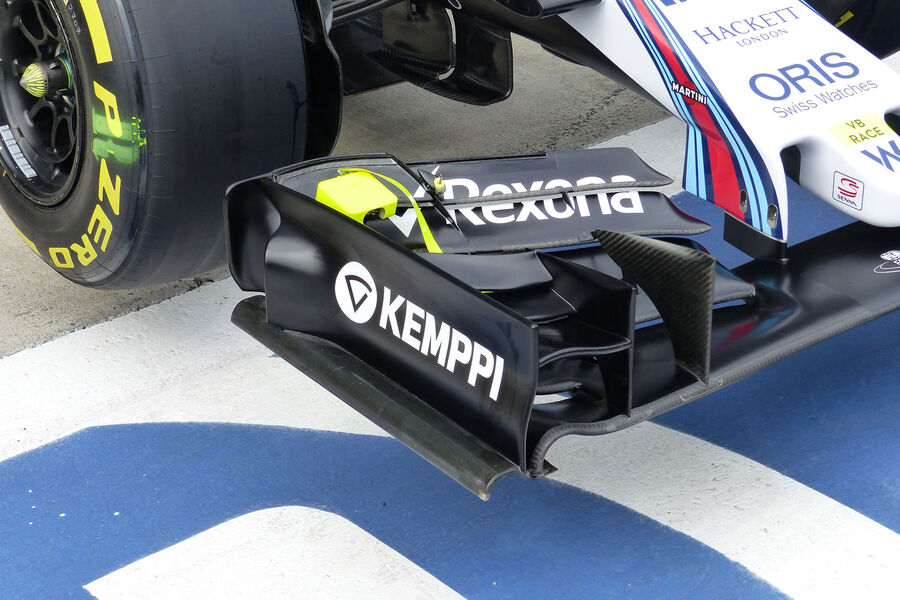And I did just so!
Took me 10 minutes actually to adjust the images. God I love paint.net for its advanced yet simple to use tools.
Red Bull philosophy (pre-Malaysia) (sorry, I don't have a better example at present. I'll be working this week on the mclarne wing)

Mercedes current philosophy:

Williams philosophy:

I made the cascades, winglets and endplates dark-transparent, to easily show in the same image what's going on underneath or behind those parts. Endplate winglets have further been recolored to green-blue.
Note the typical characteristics of the red bull wing (again, pre malaysia mind you).
-The wing element protrude through the endplate and curl directly down to the curved section of the footplate. The curled section is actually obligatory bodywork forced by the rules there. Every team has it at that exact place with the exact same room occupied. However, there are small differences in shape, some cars featuring a half ellipse, others half circle, and even others even more squared.
-The cascades have winglets with quite a big AoA. They are relative straight and I think they are more about upwashing then outwashing airflow.
-At the back, the endplate and upper element are fused as one single piece of bodywork.
-Also note how a small strake on top of that upper element tries to redirect airflow. This an important piece actually.
-Lastly, the front wing element has a very specific shape. A longly stretched half curl. This is something we see at Force India, Mclaren and Marussia too. It's important to include Marussia in this as interestingly that team did not/does not have any ex-personel from Red Bull.
-The general outboard line of the wing is relative straight.
Then note what Mercedes does:
-There's quite a big space between the curled section of the footplate, and the base of the wing elements, which is filled by extented, flat sections of footplate.
-More at the back the wing elements start to curl agressively towards the outer extremity of the footplate, creating a more agressive outwash, for both the inside and outside airflow.
-Also note how the cascades and corresponding winglets are agressively turned outwards. This something we see often with this philosophy, but not with all teams. An exception is Toro Rosso. The outboard cascade usually features low AoA winglets, while the inboard cascade usually is a turning vane. Again, very agressively bent.
-There are winglets on the inside and/or outside of the endplate. Again, it's not a general sule but often you see those.
-The front element has a short, quite agressive curl outboard. Mercedes and now Ferrari have taken this one step further and turned it into a gutter. This is a big difference with the smooth, flat and long curl of the red bull philosophy.
Then if we finally look at Williams:
-There's a very tiny spacing between the wing elements and the endplate, with no integration of the elements into the endplate, or a heavily curling towards the backend. It's a little bit of both worlds, or perhaps actually none of either worlds.
-Cascades are slightly bent outwards. The outboard one has quite a bit of AoA, while inboard is a turning vane, but again not agressively bent like we see with cars like Lotus, Mercedes and even Ferrari. This again is more mixture from both previous philosophies.
-There are no extra small winglets on the endplate or wing elements, to steer airflow towards a certain point.
-The endplate is unusual since it's relative straight while in the previous philosophies they bent outwards. the back of the endplate features a concave shape, while this is in all other cases convex.
-The shape of the first element is relative the same to the Merc philosophy. Note however Williams features a completely different slot arrangement inbetween the elements. In both RBR's and Merc's case, we have 3 elements connected to the neutral section while Williams only has one. Yes, the likes like Ferrari and Marussia also don't have that arrangement, but also note that the tips of the upper elements are different in that area, being further seperated then with any other team. Commonly we see those tips either being very close to eachother or even merged. The whole Y250 area is tackled differently then what we usually see.







